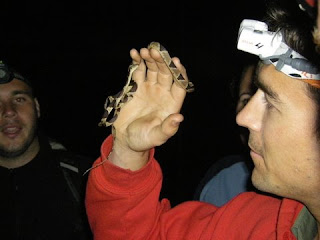Don't get me wrong, though- I am a fan of simple living and being outdoors as often as I can. In a month and a half I haven't heard a car horn, a telephone ring, or the sound of a television, and that’s been wonderful. I have slept solidly almost every night, a claim I cannot always make back home, and I have breathed nothing but fresh forest air this entire time. On the other hand, I miss spitting into a sink instead of a sand-filled bucket, warm showers (I would be ecstatic with lukewarm water at this point), being able to eat whatever I want, whenever I want, sleeping in a bed, not sharing four toilets with dozens of strangers, having electricity all day, and not having to walk across a path of cinder blocks without falling in the mud on my way to piss in a plastic pipe that has bees in and around it.
I find it amusing to hear students and volunteers make the same complaints I've just made after only a few days, and to hear the high-pitched shrieks from guys and gals alike as they endure a frigid introduction to the showers. Having been at Base Camp longer than nearly everyone, including most of the staff who are constantly heading to other camps, I feel compelled to give newcomers a Grandpa Speech: "I remember when I first got here- no meat for a few days is tolerable, but after a week without beef you'll start hallucinating and getting the shakes. Oh, and you think the 3-mile walk back from Buenos Aires is tough? When I got here, it was 5 miles and uphill in both directions."
As I said in one of my earlier posts, fighting boredom is one of the biggest challenges here, especially at night. The folks in charge do their best to keep us entertained with movies and presentations on various topics (a duty which I have narrowly but successfully avoided so far), but the same routine every nght can only yield so much fun. Sure, there is the occasional card game (I taught one of the medics how to play cribbage), soccer with the locals (guess who wins?), some music trading (I've gotten thousands of songs from three different iPods since I've been here), and the book I just started isn't bad. But, again, these little activities can only produce so much satisfaction. Fortunately for us, there is booze.

Let's face it- alcohol hasn't been around for several thousand years because it's NOT fun. There's no getting around it- drinnking is a blast. What's that, you say? You have nothing to do tonight? Then let's get some beer. Keeping with that tradition, I have observed a certain progression in the perception of and interaction with alcohol here. It goes something like this:
1. Evidently we can get a away with "a couple quiet ones" down in the village since it is on the buffer zone of the park. My first visit there I managed to suck down five beers without a problem. Yes, there was the imminent 3-mile uphill walk back to Base Camp, but it was worth every step.

2. Dude, I wonder if we could sneak a few cans back from B.A.? Turns out, we could. A small group of my English friends smuggled up a good fourteen or so beers back from the village and we polished them off that night. Unfortunately, due to an unanticipated tent occupancy inventory, the stash of cans was found before I could clean it up the next day. Whoops!
3. We should probably keep this confined to our little group. Or not. Instead, let's see how many people we can cram into a two- or three-man tent for an evening of drinking. Turns out, you can fit eight adults, a small set of speakers, and a backpack full of beer that I had gradually accumulated.
4. No way, someone scored a bottle of rum?? Beer is cool, but liquor would be ideal since it involves less cleanup and, consequently, less risk of getting caught. And, shit, it's a lot more effective at getting the job done than beer, and can even be consumed in public if enough pineapple juice or coke is mixed in.
5. OK, so now anyone can get rum, almost any day of the week. It's not available in B.A. since the locals evidently don't handle it well (I was told that the machetes eventually come out, which generally isn't conducive to a quality party). Fortunately for the well-being of Base Camp, a local entrepreneur who initially sold only hand-made bracelets and necklaces eventually expanded his product line to include $10 bottles of rum, which is likely a huge rip-off, but I've happily bought two bottles so far.

6. Joe's going-away party- one of the key players in the Opwall/Cusuco effort was our man Joe, who has been part of the organization for years but recently left for a job in the Dominican Republic. Before he left, however, we managed to squeeze in a great going-away party, complete with a BBQ that included... beef! And what's a BBQ without beverages? At the beginning of the night I quietly, sneakily sipped on my rum and pineapple, but gradually watched the scene turn into a full-on party. Damn near everyone, including staff, students, and volunteers, seemed to have a drink in hand. And not just rum- people were actually drinking cans of Salva Vida in front of the main office. Yes, this was a one-time thing, but I think it fits neatly into my list as number 6.
7. ???? I'm not sure what could top the party. Maybe we will get a keg and a bartender and some strippers next time? Who knows, but I am looking forward to it.






